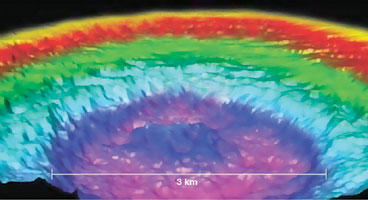What's new in exploration
A big Brazilian find. Petrobras announced a huge discovery north of Campos basin, with estimated reserves of at least 600 million boe. This was the result of appraisal drilling, when a horizontal extension, Well 3-ESS-110HPA, drilled last month by the Noble Paul Wolff, tested 3,000 bpd of 17°API oil. Calculations indicated that production could have been as high as 20,000 bpd. A six-month extended well test will now be conducted using the largest ESP ever installed, with over a 20,000-bpd capacity. The new field is located 50 mi offshore Espirito Santo state, in 4,088 ft of water. The original well, 1-ESS-100, was drilled in January 2001 and discovered a 150-ft column of oil. In May of this year, Petrobras drilled a deviated well, 6-ESS-109D, and encountered an oil column nearly 400 ft thick. In addition, a second oil column 80-ft thick was encountered that was not found in the original well. The company said it would drill two more wells during the next six months to further test the find. No big deal. I recall reading someone’s research that 50% of all mergers fail, most often because of a clash of cultures. Some companies, such as giant Western Geophysical, have been down a rocky road. Started in 1933 by Henry Salvatori, the company was sold into a joint venture with Litton and Dresser Industries in 1987 to form Western Atlas, which was then sold to Baker Hughes in 1998, and finally merged with Geco Prakla in 2000 to form Western Geco. The PGS/Veritas merger, announced last November, underwent a long time in negotiations, and, including two amendments to the "merger of equals," did not appear to be going well. The deal is now off. Perhaps they dodged a cultural bullet. Now these two fine companies can get back to their core businesses. A big deal, but a small impact. Eight months ago, BP geophysicist Phil Allen was studying a 3D seismic survey, when he saw a series of concentric rings with a central peak, higher up in younger rocks. It looked vaguely familiar, but even with 30 years’ experience, he wasn’t sure. So he hung a printout of the structure in his office with the caption, "Anyone recognize this?" Six months later, Dr. Simon Stewart came to Allen’s office to discuss a gas prospect. Stewart immediately recognized the structure. However, more mundane geologic causes had to be ruled out, such as salt diapirs and volcanic processes. After looking at additional seismic and magnetic data, plus borehole data from two wells that penetrated the structure, Stewart and Allen conclusively proclaimed it an impact crater.
There have only been six other marine impact craters discovered, but this one is unique among all 160 impact craters found thus far on Earth. The crater, called Silverpit, is located some 140 km off the eastern UK coast. It has a tall central peak and a remarkable series of concentric rings. Only the largest terrestrial craters exhibit this type of structure and are more than 250 km in diameter, but Silverpit is only 19 km across. It is theorized that a combination of soft sediments in a shallow sea created the unique structure, and a subsiding basin provided continuous supply of fine sediment that "fossilized" the structure. The timing of the event – 60 to 65 million years ago – makes it possible that it could have been a fragment of the Chicxulub asteroid that crashed into the Gulf of Mexico, a likely extinction-causing event. A complete report can be found in the August issue of Nature. When was the last time? A well-known meteorite bombardment occurred in the solar system about 3.8 to 4 billion years ago. The barrage is recorded on various worlds, such as the Moon, Mars and some of Jupiter’s moons; but until now, not on Earth. A research team from the University of Queensland analyzed 3.8-billion-year-old rocks from West Greenland. The metamorphosed sedimentary rocks contained anomalies in the isotopic composition of tungsten that match those found in meteorites. "There is no known mechanism (other than meteorites) by which these anomalies could have been preserved in the environment," said one of the researchers. When will be the next time? A Spanish aerospace company, Deimos Space, has proposed a plan to knock any threatening asteroids off course. The plan is simple: Crash a spacecraft into the asteroid at high speed and in doing so nudge the asteroid off course. A second spacecraft would accompany the first as an observer. Since the probabilities of a major asteroid strike vary from one in ten thousand to one in a million, this would have to be considered a long-range business plan. However, had it known, the company could have made some money prior to June, when. . . One just missed. Asteroid 2002MN – not to be confused with 2002NT7 or 2002NY40, both of which were recent collision-course candidates – made history on June 14 by coming closer to Earth than any large asteroid ever recorded. Unfortunately, it was discovered three days after the 75,000-mi near miss. One scientist called it a "close shave." It was a relatively small, football-field sized asteroid. Had it hit, it would have "only" wiped out about 2,000 sq. km.
|
- Quantum computing and subsurface prediction (January 2024)
- Machine learning-assisted induced seismicity characterization of the Ellenburger formation, Midland basin (August 2023)
- Regional Report: Guyana-Suriname (July 2023)
- What's new in exploration (March 2023)
- Regional Report: Brazil (February 2023)
- Seismic and its contribution to the energy transition (January 2023)




